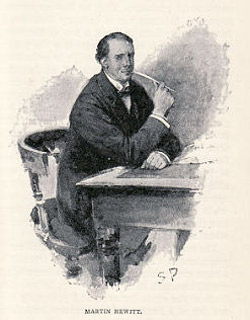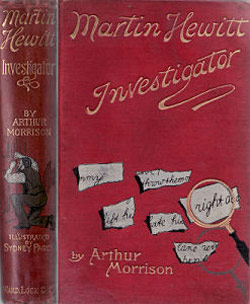
I first encountered the investigator Martin Hewitt, the creation of Arthur Morrison, while I was looking through a listing of nineteenth century mystery stories. I had never heard of him either, but I enjoyed the stories. Hewitt, I found after a little research, was a fairly well known character, particularly in the era after Sherlock Holmes apparently went over the Reichenbach Falls, and readers were hungry for more detective fiction. In between more serious, dark work, both ghost stories and realistic fiction, author Arthur Morrison published three volumes of short stories about Hewitt: Martin Hewitt, Investigator; The Chronicles of Martin Hewitt; and The Red Triangle, Being Some Further Chronicles of Martin Hewitt, Investigator.
Morrison, perhaps more interesting than his character, later became famous for writing about London slum life. It’s believed he himself grew up in a slum, and this helped him to realistically portray that environment in his fiction. At one point he spent a year and a half investigating one of London’s worst slums, Old Nichol, at the behest of a priest; he was able to fit in with the locals, though on more than one occasion only his skill at boxing saved him from attack. Those researches led to his most famous novel, a gritty moral tale titled A Child of Jago. However, the Hewitt stories aren’t similar in the least to Morrison’s proto-noir fiction; they’re all relatively lighthearted.
I was particularly interested in how Hewitt’s investigative procedures operated in comparison to those of Sherlock Holmes. Though ostensibly Hewitt depends on logic to solve crimes (“. . . I think I must ask you to begin at the first robbery and tell me the whole tale in proper order. It makes things clearer, and sets them in their proper shape.”), the stories mostly hinge on a clever gimmick. Sometimes all of the clues are provided for the reader to guess the solution, but for the most part one can only marvel at Hewitt’s cleverness in figuring out bizarre solutions, and accept the solution he presents. “I’ll explain all my tricks when the job’s done,” he said . . . Truthfully, that’s not all that far from Holmes and his methods; Holmes’s deductions were often drawn from evidence that would never have been useful in real life. Luckily, readers weren’t looking for real life!
Morrison also demonstrated his detective’s deductive skills, though.
“You see, it’s reasonable to suppose they’ve put [the prisoner] in the middle one, because that would suit their purpose best. The shops at each side of the three are occupied, and, if the prisoner struggled, or shouted, or made an uproar, he might be heard if he were in one of the shops next those inhabited. So that the middle shop is the most likely. Now, see there,” he went on, as they stopped before the window of the shop in question, “over at the back there’s a staircase not yet partitioned off. It goes down below and up above. On the stairs and on the floor near them there are muddy footmarks. These must have been made to-day, else they would not be muddy, but dry and dusty, since there hasn’t been a shower for a week till to-day. Move on again. Then you noticed that there were no other such marks in the shop. Consequently the man with the muddy feet did not come in by the front door, but by the back; otherwise he would have made a trail from the door. So we will go round to the back ourselves.”

He is not a man who has made many friendships (this, probably, for professional reasons), notwithstanding his genial and companionable manners.
Overall, Hewitt tends to confound the expectations. The omniscient narrator describes him thus:
. . . the man had always as little of the aspect of the conventional detective as may be imagined. Nobody could appear more cordial or less observant in manner, although there was to be seen a certain sharpness of the eye—which might, after all, only be the twinkle of good humor.
Rather than the rather abrasive manner of Holmes, and his array of disguises, Hewitt relied upon his personal manner that invited confidences, though at one point he dons spectacles as a rudimentary disguise. I found this aspect of especial interest, since it made me wonder how much Morrison’s own skill at infiltration affected the creation of his character.
It was, of course, always a part of Martin Hewitt’s business to be thoroughly at home among any and every class of people, and to be able to interest himself intelligently, or to appear to do so, in their various pursuits.
Unlike Holmes, Hewitt is a people person.
“There will be no trouble about evidence; he’ll confess. Of that I’m sure. I know the sort of man.” Also, “Hewitt’s personal relations with the members of the London police force were of a cordial character.”
Morrison’s description of Hewitt’s office gave me a distinct impression of 1930s private detective movies, making me wonder if any of those filmmakers had read it, or if it was simply a coincidence.
At the head of the first flight of a dingy staircase leading up from an ever-open portal in a street by the Strand stood a door, the dusty ground-glass upper panel of which carried in its center the single word “Hewitt,” while at its right-hand lower corner, in smaller letters, “Clerk’s Office” appeared.
I began to wonder what a television version of the Hewitt mysteries would be like!
If you’re interested in reading some of the Martin Hewitt stories yourself, they are in the public domain and available for free download at Gutenberg.org.
Victoria Janssen is the author of three novels and numerous short stories. Her World War I-set Spice Brief, “Under Her Uniform,” is a tie-in to her novel The Moonlight Mistress. Follow her on Twitter: @victoriajanssen or find out more at victoriajanssen.com.
Read all posts by Victoria Janssen for Criminal Element.

These stories sound fascinating! Off to Gutenberg I go.
@bibliobeque – I hope you enjoy the stories!
Actually you can see a TV version of the character. Back in the early ’70s, the ITV network in the UK broadcast two series’ worth of mystery dramas called The Rivals of Sherlock Holmes. It was an anthology series that adapted detective stories by contemporaries of Arthur Conan Doyle. Two of the episodes in series one featured Martin Hewitt, as portrayed by Peter Barkworth. Both series were released on DVD in the US a few years ago and are still in print (and available through Netflix and the like). The two Hewitt adaptions were The Affair of the Tortoise and The Case of Laker, Absconded.
@RonB – THANK YOU. That is so cool! I had no idea.